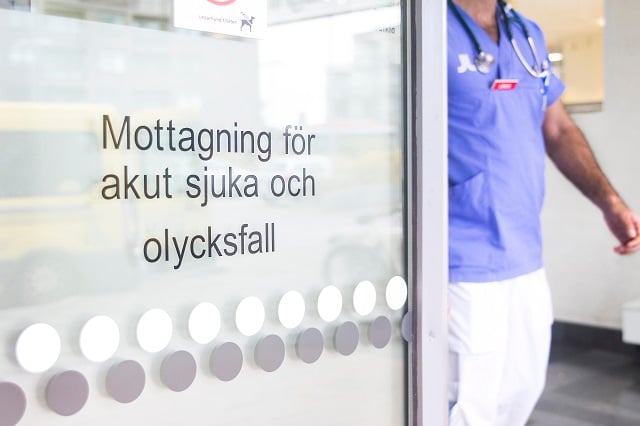The very first thing to understand is that in order to practice medicine in Sweden, you require a Swedish medical licence (legitimation). This applies to 21 different medical professions, but for some healthcare positions such as assistant nurses, you can find work in Sweden without the licence (and in some cases, with reduced requirements of language skills).
Whether you're eligible for the licence, and how to apply, varies slightly depending on your specialism and on which country you trained in. We've split our guide into three parts: for those who received their qualifications from a country in the EU/EEA/Switzerland, for those who received medical qualifications from a non-EU/EEA country (click here), and those without qualifications who wish to train as a doctor in Sweden (click here).
READ ALSO: These are the most future-proof jobs for the next five years in Sweden
For doctors trained within the EU/EEA/Switzerland
If you've completed basic training in an EU or EEA country or Switzerland, your qualifications normally benefit from automatic recognition in Sweden. The same goes for specialist training, as long as both Sweden and the country where you undertook the training have reported the specialty at issue to Annex V of Directive 2005/36/EC and your application is followed by a certificate issued by the competent authority in the country of training. Even if your training took place outside this area, you can follow these instructions if you have since been awarded a licence in an EU/EEA country and practiced there for at least three years, and received a certificate from the competent authority in that country.
As for any British trained professional who is anxious about what might apply to them after Brexit, the Swedish government has said it will continue to recognize the qualifications of all Brits working in the medical and healthcare fields even in the event of a no-deal Brexit, so long as the application is received before Brexit. That leaves aspiring doctors with a very short window to send in their documents, since it's unclear what would happen to British doctors applying after a no-deal Brexit. If the UK agrees a deal with the EU before leaving however, both sides have already agreed that medical qualifications would continue to be mutually recognized.
READ ALSO: How the Swedish healthcare system works

File photo: Isabell Höjman/TT
The application for a licence to practice as a doctor should be sent to Socialstyrelsen (The National Board of Health and Welfare).
You'll need to send the following things: an extract from the Swedish population register (personbevis), which is no older than three months; your Swedish personal identity number (personnummer) if you have it or a valid passport (plus proof of any name changes), a certificate proving your Swedish language skills; a copy of your qualifications themselves; a certificate no older than three months proving you haven't been banned from the profession; a certificate which confirms that you meet either article 23 or 24 in EU directive 2005/36/EC; and proof that you have paid the application fee. Do not send original documents; ordinary copies are sufficient.
The fee is 2,300 kronor and is paid directly to Socialstyrelsen. All documents in a language other than Swedish, English, Norwegian or Danish need to be translated into either Swedish or English.
Once you have all the required documents and information, you can fill out the form online (here for EU/EEA/Switzerland trained doctors) or send off a printed copy (found here).
When it comes to the language requirement, generally you will have to take a course to demonstrate you have reached C1 level Swedish according to the CEFR (Common European Framework of Reference) or Swedish/Swedish as a foreign language, level 3 from Komvux (upper secondary adult education) or another course or test that makes you eligible for studying at a Swedish university/college. But there are a few exceptions. If you speak C1-level Danish or Norwegian, your knowledge of these languages is sufficient to practice medicine in Sweden. Regardless of your citizenship you must prove your skills in any of the three above-mentioned languages.
Instead of taking one of these qualifications, it is possible to apply for your medical licence if a healthcare provider can confirm that you have sufficient Swedish knowledge to work there. In that case, they need to fill out a form (here) that should then be included on your licence application.

File photo: Isabell Höjman/TT
For doctors trained outside the EU/EEA/Switzerland
For those whose training was completed outside the EU/EEA/Switzerland, the process is a little more complex.
The first step is to have your qualifications from your home country translated into either English or Swedish and send them to Socialstyrelsen for assessment, along with copies of the original documents and identification.
The next step is to take a two-part medical exam that tests your theoretical and practical medical knowledge. This is done in Swedish, so you will need to have sufficient language skills in order to pass the test.
Because of the language requirement, it's a good idea to start learning Swedish as soon as possible once you've decided to make the move. Even if you're outside the country, it's possible to do this using resources such as the Swedish Institute's Learning Swedish course, the app Duolingo, and of course The Local's language section, and you can also find many more intensive paid courses or one-on-one teachers either online or in person, if you're in a major city.
READ ALSO: Six tips for learning Swedish without even being in Sweden
To get your licence, you need to prove your Swedish is at level C1 according to the CEFR (Common European Framework of Reference). This means you have a high level of understanding of written and spoken Swedish in varied and complex contexts, and can produce clear and well-structured Swedish in speech and writing. A few different qualifications are accepted: Komvux qualifications in Swedish 3 or Swedish as a Second Language 3; a qualification that meets the language requirements for higher education (such as Tisus, or the qualifications listed here).
After that, you need to take an online course about medical law in Sweden and then undertake a period of clinical training.
After that, it's possible to apply for the medical licence, which should be processed within about two weeks.
FIND A JOB: Browse thousands of English-language jobs in Sweden

Photo: Claudio Bresciani/TT
Training as a doctor in Sweden
It is also possible to apply for a licence after carrying out training in Sweden.
You can choose to start from scratch by undertaking a degree in medicine in Sweden, and then applying for your licence once the five to six year course is complete. If you have studied in a different country, you can speak to university admission offices to see if it's possible to carry out a reduced period of study.
Another option if you already have a degree in medicine from a non-EU/EEA country is to undergo additional training in Sweden, which can be done at five locations: Karolinska Institute in Stockholm, or the universities of Gothenburg, Lund, Linköping, or Umeå. This is around one year of full-time theoretical and practical study (requiring a high level of Swedish knowledge), and once this is completed you can apply for your Swedish medical licence.
If you choose to go down the route of further study in Sweden, the websites antagning.se and studera.nu offer information about the different courses and requirements at Swedish universities.
MORE CAREER GUIDES:


 Please whitelist us to continue reading.
Please whitelist us to continue reading.
Member comments